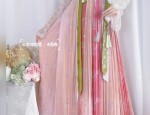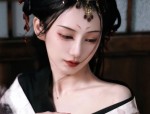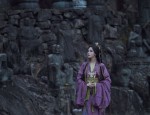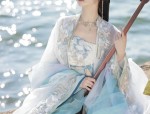The Fabric Journey of Traditional Hanfu Costumes:Materials and Their Cultural Significance
In the realm of ancient Chinese fashion, Hanfu costumes hold a unique position, reflecting a rich tapestry of cultural heritage and craftsmanship. The art of Hanfu lies not only in its intricate designs but also in the selection of materials used to craft these traditional garments. This article delves into the world of Hanfu materials, exploring their origins, significance, and role in creating the allure of these timeless costumes.

At the core of Hanfu lies the meticulous selection of materials. The most commonly used materials for Hanfu are silk, cotton, and other natural fibers. Silk, a symbol of luxury and elegance, is often employed in the creation of intricate patterns and designs. Its softness and shine complement the intricate embroidery and patterns found in Hanfu. Cotton, on the other hand, provides durability and breathability, essential for everyday wear. It is often used in the outer layers of clothing, where it provides protection from the elements.
In addition to these natural fibers, other materials such as hemp and linen are also employed in the creation of Hanfu. These materials were commonly used in ancient times due to their availability and durability. Hemp, in particular, was highly valued for its resistance to wear and tear, making it an ideal material for long-lasting clothing.
The selection of materials for Hanfu is not just about their physical properties but also about their cultural significance. Each material holds a specific cultural meaning and symbolizes certain values. Silk, for instance, represents luxury and nobility, while cotton embodies simplicity and purity. The use of these materials in Hanfu reflects the wearer’s status, preferences, and cultural identity.
The craftsmanship involved in the creation of Hanfu is also closely linked to the selection of materials. Different techniques such as embroidery, printing, and beading are applied to the materials to create stunning patterns and designs. These techniques not only enhance the aesthetic value of Hanfu but also add to its cultural significance.
Moreover, the regional variations in Hanfu are also influenced by the availability of materials. Different regions of China have their own unique materials that are locally sourced and employed in the creation of Hanfu. These regional materials contribute to the uniqueness and diversity of Hanfu styles, reflecting the rich cultural heritage of different regions.
In conclusion, the art of Hanfu lies not only in its designs but also in the selection of materials used to craft these traditional garments. The use of silk, cotton, hemp, and other natural fibers not only enhances the physical properties of Hanfu but also embodies its cultural significance. The meticulous selection of materials, combined with skilled craftsmanship, creates a seamless blend of beauty and culture that continues to captivate hearts across the globe. As Hanfu continues to gain popularity, it is important to appreciate and understand the role of materials in creating these timeless costumes that embody China’s rich cultural heritage.
The journey of Hanfu is not just a journey of fashion but also a journey of material exploration and cultural understanding. As we delve deeper into the world of Hanfu materials, we discover a world that is rich in history, culture, and craftsmanship, reflecting a legacy that dates back thousands of years.

 Previous Post
Previous Post








